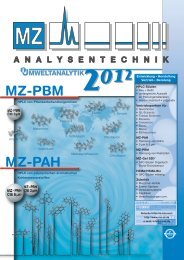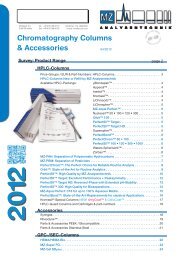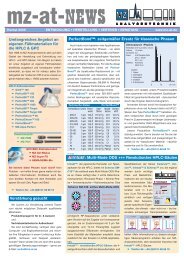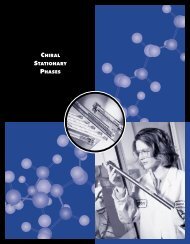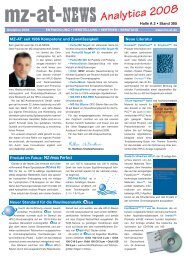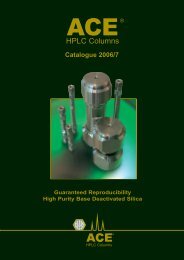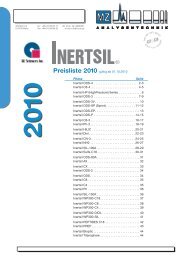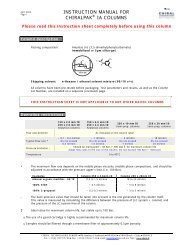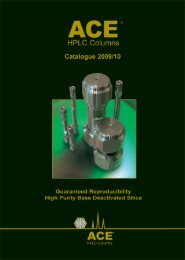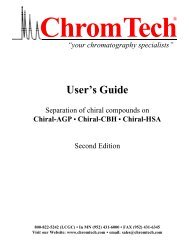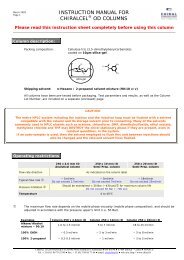Halo PFP - at MZ-Analysentechnik
Halo PFP - at MZ-Analysentechnik
Halo PFP - at MZ-Analysentechnik
Create successful ePaper yourself
Turn your PDF publications into a flip-book with our unique Google optimized e-Paper software.
HALO <strong>PFP</strong> UHPLC COLUMNS<br />
®<br />
The name th<strong>at</strong> defi nes a new<br />
direction in UHPLC separ<strong>at</strong>ions.
UHPLC columns<br />
comp<strong>at</strong>ible with<br />
both UHPLC and<br />
conventional<br />
HPLC equipment
<strong>PFP</strong> UHPLC Columns<br />
• Vers<strong>at</strong>ile UHPLC columns th<strong>at</strong><br />
can be used with either UHPLC or<br />
conventional HPLC equipment<br />
• An altern<strong>at</strong>e bonded phase selectivity<br />
to achieve separ<strong>at</strong>ions not possible<br />
with other bonded phases<br />
• Particularly recommended for bases<br />
and halogen<strong>at</strong>ed compounds<br />
• Comp<strong>at</strong>ible with highly aqueous<br />
mobile phases to facilit<strong>at</strong>e the retention<br />
and separ<strong>at</strong>ion of polar compounds<br />
• Stable bonded phase provides durable,<br />
long-lived performance plus minimum<br />
bleed for LC/MS applic<strong>at</strong>ions<br />
• Base-deactiv<strong>at</strong>ed for good peak shape<br />
when separ<strong>at</strong>ing basic compounds<br />
• Moder<strong>at</strong>e back pressure places less<br />
stress on UHPLC equipment and<br />
permits these UHPLC columns<br />
to be used with conventional HPLC<br />
equipment.<br />
• The use of 2 µm porosity column inlet<br />
frits reduces the inconvenience caused<br />
by pressure increases from plugged frits<br />
and makes HALO columns more<br />
forgiving and easier to use than columns<br />
packed with sub-2 µm particles.<br />
H<br />
ALO Fused-Core® particle technology facilit<strong>at</strong>es ultra-fast, high<br />
resolution UHPLC separ<strong>at</strong>ions with either UHPLC or conventional<br />
HPLC equipment. Now HALO columns packed with a pentafl uorophenyl<br />
phase (<strong>PFP</strong>) join HALO C18, C8, RP-Amide, Phenyl-Hexyl and HILIC<br />
phases to offer a wide range of powerful selectivity choices to accomplish the most<br />
demanding separ<strong>at</strong>ions. HALO <strong>PFP</strong> is particularly well suited for the separ<strong>at</strong>ion of<br />
halogen<strong>at</strong>ed compounds, nitro-arom<strong>at</strong>ic compounds, and polar bases. HALO <strong>PFP</strong><br />
defi nitely should be considered when a C18 or C8 phase fails to provide an adequ<strong>at</strong>e<br />
separ<strong>at</strong>ion. HALO <strong>PFP</strong> columns are also well suited for the separ<strong>at</strong>ion of highly<br />
w<strong>at</strong>er soluble compounds th<strong>at</strong> require high aqueous mobile phases and generally<br />
provide gre<strong>at</strong>er retention for bases than C18 phases.<br />
HALO <strong>PFP</strong> | 1
HALO <strong>PFP</strong> uses proprietary bonding chemistry to achieve excellent stability and<br />
long column life. The extremely low bleed characteristics of the HALO <strong>PFP</strong> phase<br />
make it particularly well suited for LC/MS applic<strong>at</strong>ions.<br />
As with all HALO phases, the combin<strong>at</strong>ion of ultra-pure reagents, “Type B” silica,<br />
dense bonding technology, and optimized endcapping produce a base-deactiv<strong>at</strong>ed<br />
st<strong>at</strong>ionary phase th<strong>at</strong> provides excellent peak shape for basic compounds.<br />
Mechanism of Separ<strong>at</strong>ion<br />
Reversed phase separ<strong>at</strong>ions on HALO <strong>PFP</strong> columns are primarily infl uenced by<br />
hydrogen bonding and dipole-dipole interactions. However, π–π interactions and<br />
mild hydrophobic binding interactions often contribute to retention and selectivity.<br />
In addition, the polar <strong>PFP</strong> group makes the HALO <strong>PFP</strong> phase a suitable choice for<br />
HILIC applic<strong>at</strong>ions. (See Figure 1 for the structure of the <strong>PFP</strong> bonded phase.)<br />
FIGURE 1: Structure of HALO <strong>PFP</strong> bonded phase<br />
F<br />
Pentafl uorophenylpropyl is the bonded phase used for HALO <strong>PFP</strong>.<br />
The fused-core silica column providing the reduced diffusional mass transfer p<strong>at</strong>h<br />
allows the use of shorter columns and higher fl ow r<strong>at</strong>es to achieve remarkably fast<br />
high-resolution separ<strong>at</strong>ions. Analytical Chemistry, August 2007<br />
2 | HALO <strong>PFP</strong><br />
F<br />
F<br />
F<br />
F
Figure 2 illustr<strong>at</strong>es the difference in selectivity offered by HALO <strong>PFP</strong> versus<br />
HALO C18. The improved separ<strong>at</strong>ion of 1-phenylnaphthalene and pyrene on<br />
HALO <strong>PFP</strong> is due to π–π interactions. The stronger hydrophobic binding interaction<br />
on the HALO C18 is responsible for the longer retention of butylbenzene and<br />
for the dram<strong>at</strong>ic difference in selectivity represented by the change in elution order<br />
between butylbenzene and acenaphthene on HALO C18 versus HALO <strong>PFP</strong>.<br />
FIGURE 2: HALO <strong>PFP</strong> offers an altern<strong>at</strong>e selectivity to HALO C18<br />
TEST CONDITIONS:<br />
Column Dimensions: 4.6 x 50 mm<br />
Mobile Phase: 30/70 w<strong>at</strong>er/methanol<br />
Flow R<strong>at</strong>e: 2.0 mL/min.<br />
Pressure: approxim<strong>at</strong>ely 250 Bar<br />
Temper<strong>at</strong>ure: 40 °C<br />
Detection: UV 254 nm, VWD<br />
Absorbance<br />
Absorbance<br />
HALO C18<br />
2<br />
0 1 2 3 4 5<br />
Minutes<br />
HALO <strong>PFP</strong> 4<br />
1<br />
3<br />
2<br />
PEAK IDENTITIES:<br />
1. Butylbenzene<br />
2. Acenaphthene<br />
3. 1-Phenylnaphthalene<br />
4. Pyrene<br />
0 1 2 3 4 5<br />
Minutes<br />
This separ<strong>at</strong>ion of neutral arom<strong>at</strong>ic compounds illustr<strong>at</strong>es the differences in selectivity between<br />
HALO <strong>PFP</strong> and HALO C18. The ��� interactions offered by the <strong>PFP</strong> phase and the stronger<br />
hydrophobic interactions of the C18 phase lead to signifi cant differences in band spacing and<br />
even peak elution order on the two phases. This difference in selectivity makes HALO <strong>PFP</strong> an<br />
extremely useful altern<strong>at</strong>e selectivity to the HALO C18 phase th<strong>at</strong> should be evalu<strong>at</strong>ed when<br />
developing separ<strong>at</strong>ions.<br />
1<br />
3<br />
4<br />
HALO <strong>PFP</strong> | 3
Figure 3 illustr<strong>at</strong>es the role th<strong>at</strong> dipole-dipole interactions and π–π interaction play<br />
in achieving a separ<strong>at</strong>ion. Although it is difficult to identify which interaction is most<br />
dominant for each analyte, these comparison chrom<strong>at</strong>ograms clearly show th<strong>at</strong> these<br />
different mechanisms of separ<strong>at</strong>ion (dipole-dipole interactions more dominant with<br />
the <strong>PFP</strong> phase and π–π and hydrophobic interactions more dominant with the<br />
Phenyl-Hexyl phase) can be used to develop a s<strong>at</strong>isfactory separ<strong>at</strong>ion.<br />
FIGURE 3: HALO <strong>PFP</strong> and HALO Phenyl-Hexyl offer different selectivity<br />
TEST CONDITIONS:<br />
Column Dimensions: 4.6 x 50 mm<br />
Mobile Phase: 45/55 w<strong>at</strong>er/methanol<br />
Flow R<strong>at</strong>e: 1.5 mL/min.<br />
Pressure: approxim<strong>at</strong>ely 200 Bar<br />
Temper<strong>at</strong>ure: 40 °C<br />
Detection: UV 254 nm, VWD<br />
Absorbance<br />
Absorbance<br />
HALO <strong>PFP</strong><br />
HALO Phenyl-Hexyl<br />
0 1 2 3 4 5<br />
Minutes<br />
These comparison chrom<strong>at</strong>ograms clearly show the effect of different mechanisms of separ<strong>at</strong>ion:<br />
dipole-dipole interactions more dominant with the <strong>PFP</strong> phase and ��� and hydrophobic interactions<br />
more dominant with the Phenyl-Hexyl phase. These differences in interaction between analytes and<br />
st<strong>at</strong>ionary phase can be utilized to achieve superior separ<strong>at</strong>ions.<br />
4 | HALO PPF<br />
1<br />
1<br />
2<br />
0 1 2 3 4 5<br />
Minutes<br />
4<br />
3<br />
5<br />
2<br />
PEAK IDENTITIES:<br />
1. Nitrobenzene<br />
2. 1-Cl-4-Nitrobenzene<br />
3. 2,6-Dinitrotoluene<br />
4. 4-Nitrotoluene<br />
5. 3-Nitrotoluene<br />
6. 4-Cl-3-Nitroanisole<br />
3<br />
4<br />
5<br />
6<br />
6
Figure 4 provides an example of the gre<strong>at</strong> vers<strong>at</strong>ility of HALO <strong>PFP</strong>. Here, basic<br />
drugs are separ<strong>at</strong>ed using HILIC mode. This can be particularly useful for separ<strong>at</strong>ing<br />
polar compounds th<strong>at</strong> are poorly retained in reversed phase mode. In addition,<br />
HILIC mode typically involves oper<strong>at</strong>ing with higher amounts of organic component<br />
in the mobile phase than reversed phase mode, thus enhancing sensitivity when<br />
using LC/MS.<br />
FIGURE 4: The vers<strong>at</strong>ility of HALO <strong>PFP</strong> is shown in this separ<strong>at</strong>ion of basic drugs using<br />
HILIC mode of separ<strong>at</strong>ion<br />
TEST CONDITIONS:<br />
Column Dimensions: 4.6 x 50 mm<br />
Mobile Phase: 12/88 0.01 M ammonium<br />
form<strong>at</strong>e buffer, pH=3.0 /Acetonitrile<br />
1<br />
Flow R<strong>at</strong>e: 1.5 mL/min.<br />
4<br />
Pressure: 75 Bar<br />
3<br />
Temper<strong>at</strong>ure: 30 °C<br />
Detection: UV 254 nm, VWD<br />
Absorbance<br />
Highly polar compounds th<strong>at</strong> are poorly retained in reversed phase mode can be strongly retained<br />
on HALO <strong>PFP</strong> using HILIC mode. HILIC often provides higher sensitivity for LC-MS applic<strong>at</strong>ions due<br />
to the higher concentr<strong>at</strong>ion of organic component in the mobile phase.<br />
FIGURE 5: Fused-Core Particle Technology<br />
Porous Layer<br />
Solid Core<br />
2<br />
0 1 2<br />
Minutes<br />
3 4<br />
5<br />
0.5 µm<br />
6<br />
1.7 µm 2.7 µm<br />
PEAK IDENTITIES:<br />
1. Phenylephrine<br />
2. Trazadone<br />
3. Procaine<br />
4. Amoxapine<br />
5. Propranolol<br />
6. Desipramine<br />
Fused-Core particle technology<br />
was conceived of<br />
and developed by Dr. Jack<br />
Kirkland to produce HPLC<br />
columns th<strong>at</strong> deliver<br />
UHPLC performance with<br />
conventional HPLC<br />
equipment. As the name<br />
implies, Fused-Core<br />
particles are manufactured<br />
by fusing a porous silica<br />
layer onto a solid silica<br />
particle.<br />
HALO <strong>PFP</strong> | 5
FIGURE 6: HALO columns deliver more separ<strong>at</strong>ing power<br />
5 µm<br />
3.5 µm<br />
Sub-2 µm<br />
HALO UHPLC Columns | High resolution, Hyper-fast, Super-rugged<br />
3 µm<br />
2.2 µm<br />
HALO Fused-Core particles are designed for high speed, high resolution liquid<br />
chrom<strong>at</strong>ography. They are unique particles consisting of a 0.5 µm porous silica “halo”<br />
fused to a 1.7 µm solid silica core (Figure 5). The high density and extremely narrow<br />
size distribution of these Fused-Core particles facilit<strong>at</strong>e the packing of columns with<br />
unexpectedly high efficiencies—efficiencies more in line with wh<strong>at</strong> you would expect<br />
from columns packed with sub-2 µm particles. The reason for this unexpectedly high<br />
efficiency is apparently the unusually well-ordered packed bed th<strong>at</strong> minimizes the<br />
eddy diffusion contribution to band broadening. HALO columns do, however, gener<strong>at</strong>e<br />
the back pressure th<strong>at</strong> one would expect from columns packed with 2.7 µm size<br />
particles. This pressure is low enough to permit HALO columns to be used effectively<br />
with conventional HPLC equipment, avoiding the need to purchase expensive<br />
UHPLC equipment. However, to take full advantage of the UHPLC performance<br />
offered by these columns, the use of UHPLC equipment is encouraged.<br />
HALO columns deliver over 90% more separ<strong>at</strong>ing power (theoretical pl<strong>at</strong>es) than a<br />
column of the same length packed with 3.5 µm particles and almost three times the<br />
pl<strong>at</strong>es of a column packed with 5 µm particles (Figure 6). And, because of Fused-<br />
Core particle technology, HALO columns maintain their resolving power <strong>at</strong> high<br />
mobile phase velocity. This means th<strong>at</strong> shorter columns and higher flow velocities<br />
can be used to achieve remarkably fast high resolution separ<strong>at</strong>ions.<br />
HALO<br />
0 50,000 100,000 150,000 200,000 250,000<br />
Efficiency: N/Meter<br />
HALO columns deliver over 90% more separ<strong>at</strong>ing power (theoretical pl<strong>at</strong>es) than columns of the<br />
same length packed with 3.5 µm particles and almost three times the separ<strong>at</strong>ing power of columns<br />
packed with 5 µm particles.<br />
Note: N/Meter values were calcul<strong>at</strong>ed <strong>at</strong> the optimum mobile phase linear velocity for each of these<br />
st<strong>at</strong>ionary phases.<br />
6 | HALO PPF
The combin<strong>at</strong>ion of extremely narrow particle size distribution and very dense<br />
particles allows for the production of columns th<strong>at</strong> are incredibly rugged and reliable,<br />
even when used under conditions of high pressure and high flow velocity. In<br />
addition, the narrow size distribution of the Fused-Core particles permits the use of<br />
2 µm porosity inlet frits on HALO columns. This is the same inlet frit porosity<br />
typically found on columns packed with 5 µm particles. As a result, HALO columns<br />
are capable of delivering speed and resolution similar to columns packed with sub-2<br />
µm particles, but with the ease of use and durability of columns packed with<br />
5 µm particles.<br />
HALO <strong>PFP</strong> | 7
Specifi c<strong>at</strong>ions<br />
St<strong>at</strong>ionary Phase Support<br />
• Ultra-pure, “Type B” silica<br />
• Particle Size: 2.7 microns (1.7 micron solid core particle with a 0.5 micron porous<br />
silica layer fused to the surface)<br />
• 150 m 2 /gram surface area<br />
• 90 Å pore size<br />
Bonded Phase<br />
• Pentafl uorophenylpropyl<br />
• Densely bonded phase (ca. 3.6 µmoles/m2 )<br />
• Optimized endcapping<br />
Maximum Pressure: 9,000 psi, 600 Bar<br />
pH Range: 2 to 8<br />
<strong>PFP</strong> Ordering Inform<strong>at</strong>ion<br />
HALO® 2.7 µm Fused-Core ® Columns<br />
Description (mm) Part Number<br />
2.1 X 30mm 92812-307<br />
2.1 X 50mm 92812-407<br />
2.1 X 75mm 92812-507<br />
2.1 X 100mm 92812-607<br />
2.1 X 150mm 92812-707<br />
3.0 X 30mm 92813-307<br />
3.0 X 50mm 92813-407<br />
3.0 X 75mm 92813-507<br />
3.0 X 100mm 92813-607<br />
3.0 X 150mm 92813-707<br />
4.6 X 30mm 92814-307<br />
4.6 X 50mm 92814-407<br />
4.6 X 75mm 92814-507<br />
4.6 X 100mm 92814-607<br />
4.6 X 150mm 92814-707<br />
HALO and Fused-Core are registered trademarks of Advanced M<strong>at</strong>erials Technology, Inc.<br />
info@advanced-m<strong>at</strong>erials-tech.com<br />
www.advanced-m<strong>at</strong>erials-tech.com
info@mz-<strong>at</strong>.de www.mz-<strong>at</strong>.de<br />
Lieferprogramm HALO HPLC-Säulen<br />
➠ Das Original von Advanced M<strong>at</strong>erials Technology<br />
➠ Hochreines “Type B” Silicam<strong>at</strong>erial • Druckstabil bis 600 bar<br />
➠ Garantiert mehr als 200.000 theoretische Böden pro Meter<br />
➠ Verwendbar in konventionellen HPLC-Anlagen<br />
➠ Erlaubt extrem kurze Analysenzeiten<br />
<strong>Halo</strong> C18 C8 HILIC Phenyl-Hexyl <strong>PFP</strong> RP-Amide Peptide ES-C18<br />
LxID [mm] Best.-Nr. Best.-Nr. Best.-Nr. Best.-Nr. Best.-Nr. € Best.-Nr. € Best.-Nr. €<br />
50x0,075 98219-402 98219-408 450,--<br />
150x0,075 98219-702 98219-708 585,--<br />
50 x 0,1 98218-402 98218-408 450,--<br />
150 x 0,1 98218-702 98218-708 585,--<br />
50 x 0,2 98217-402 98217-408 450,--<br />
150 x 0,2 98217-702 98217-708 585,--<br />
50 x 0,3 98216-402 98216-408 450,--<br />
150 x 0,3 98216-702 98216-708 585,--<br />
50 x 1,0 92811-402 325,--<br />
100 x 1,0 92811-602 500,--<br />
150 x 1,0 92811-702 585,--<br />
20 x 2,1 92812-202 92812-208 92812-201 92812-206 92812-209 325,-- 92812-207 360,--<br />
30 x 2,1 92812-302 92812-308 92812-301 92812-306 92812-309 325,-- 92812-307 360,-- 92122-302 325,--<br />
50 x 2,1 92812-402 92812-408 92812-401 92812-406 92812-409 420,-- 92812-407 455,-- 92122-402 420,--<br />
75 x 2,1 92812-502 92812-508 92812-501 92812-506 92812-509 450,-- 92812-507 485,-- 92122-502 450,--<br />
100 x 2,1 92812-602 92812-608 92812-601 92812-606 92812-609 500,-- 92812-607 540,-- 92122-602 500,--<br />
150 x 2,1 92812-702 92812-708 92812-701 92812-706 92812-709 585,-- 92812-707 620,-- 92122-702 585,--<br />
20 x 3,0 92813-202 92813-208 92813-201 92813-206 325,-- 92813-207 360,--<br />
30 x 3,0 92813-302 92813-308 92813-301 92813-306 92813-309 325,-- 92813-307 360,-- 92123-302 325,--<br />
50 x 3,0 92813-402 92813-408 92813-401 92813-406 92813-409 420,-- 92813-407 455,-- 92123-402 420,--<br />
75 x 3,0 92813-502 92813-508 92813-501 92813-506 92813-509 450,-- 92813-507 485,-- 92123-502 450,--<br />
100 x 3,0 92813-602 92813-608 92813-601 92813-606 92813-609 500,-- 92813-607 540,-- 92123-602 500,--<br />
150 x 3,0 92813-702 92813-708 92813-701 92813-706 92813-709 585,-- 92813-707 620,-- 92123-702 585,--<br />
20 x 4,6 92814-202 92814-208 92814-201 92814-206 325,-- 92814-207 360,--<br />
30 x 4,6 92814-302 92814-308 92814-301 92814-306 92814-309 325,-- 92814-307 360,-- 92124-302 325,--<br />
50 x 4,6 92814-402 92814-408 92814-401 92814-406 92814-409 420,-- 92814-407 455,-- 92124-402 420,--<br />
75 x 4,6 92814-502 92814-508 92814-501 92814-506 92814-509 450,-- 92814-507 485,-- 92124-502 450,--<br />
100 x 4,6 92814-602 92814-608 92814-601 92814-606 92814-609 500,-- 92814-607 540,-- 92124-602 500,--<br />
150 x 4,6 92814-702 92814-708 92814-701 92814-706 92814-709 585,-- 92814-707 620,-- 92124-702 585,--<br />
<strong>Halo</strong>Guard Vorsäulensysteme<br />
➠ Kartuschenwechsel ohne Werkzeug<br />
➠ druckstabil bis 1.000 bar<br />
➠ totvolumenarm<br />
➠ geeignet auch für die UHPLC<br />
Vorsäulen- <strong>Halo</strong> C18 C8 HILIC Phenyl-Hexyl <strong>PFP</strong> RP-Amide Peptide ES-C18<br />
kartuschen LxID [mm] Best.-Nr. Best.-Nr. Best.-Nr. Best.-Nr. Best.-Nr. Best.-Nr. €<br />
je 3 Stück 5 x 2,1 92812-102 92812-108 92812-101 92812-106 92812-109 92812-107 92122-102 285,--<br />
5 x 3,0 92813-102 92813-108 92813-101 92813-106 92813-109 92813-107 92123-102 285,--<br />
5 x 4,0 92814-102 92814-108 92814-101 92814-106 92814-109 92814-107 92124-102 285,--<br />
Halter 94900-001 220,--<br />
<strong>MZ</strong>-ANALYSENTECHNIK GMBH . Wöhlerstraße 2–6 . D-55120 Mainz . Tel. +49-(0)6131/68 66 19 . Fax 68 66 20<br />
Der Nachdruck, auch auszugsweise, bedarf der schriftlichen Genehmigung der <strong>MZ</strong>-<strong>Analysentechnik</strong> GmbH. Alle Rechte vorbehalten. Liefer- und Zahlungsbedingungen: Ab € 500,--<br />
Warenwert Lieferung frei Haus, bis € 499,-- Warenwert zzgl. Versandkosten. Alle Preisangaben zzgl. gesetzl. MwSt. Preisänderungen und Irrtum vorbehalten.<br />
NEU!



